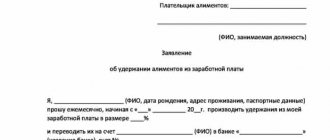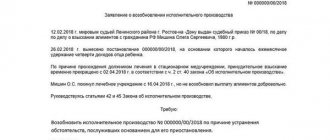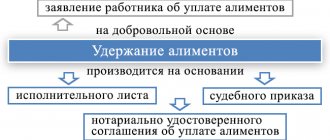Home » Alimony » Payment of alimony without a writ of execution
1
When paying alimony, a writ of execution is a document according to which deductions are made in favor of the person in need. In the vast majority of cases, alimony is provided by mothers of minor children by going to court or agreeing with their spouse on a monthly transfer of money for the child. If the father does not mind supporting the children without exerting external pressure, you can do without a writ of execution.
What is a writ of execution and who issues it?
When a child support case is heard in court in enforcement proceedings, the court first makes a decision. After this, the parties are given a month to appeal it if they disagree with something.
If neither party exercises this right, the decision will enter into force, and on its basis the plaintiff will be issued a writ of execution.
This is a document that allows you to contact bailiffs in order to forcefully collect money from the defendant. It, along with the application, is transferred to the bailiff service, after which the bailiffs initiate proceedings in the case and begin to collect alimony.
However, a writ of execution is not the only document by which forced collection of money can be carried out. In addition to it, there is also an agreement (agreement) on alimony and a court order. These documents, by law, are the same executive documents as the sheet.
Voluntary payment procedure
Responsible parents, even when relations deteriorate, care about the well-being of their children and do not need binding documents. Alimony can be paid without IL or agreement, that is, on a voluntary basis.
Agreeing on the payment of alimony without a writ of execution means unconditionally trusting your husband (wife). The payer may disappear at any time, and claiming alimony will take a long time, or the recipient, despite regular receipts, will file for alimony for the previous period. The payer needs to protect himself by transferring money and other material assets correctly: against a receipt, by postal or bank transfer with a note indicating the purpose of payment.
Receipts and receipts for the transfer of funds must be kept. If a child support dispute is heard in the courtroom, you can always show the judge evidence of regular assistance to the child.
Example. Citizen U. voluntarily received funds from her husband to support her son in the amount of 8 thousand rubles. monthly. The husband sent money by bank transfer with the note “Alimony for the n month of XXXX.” This went on for 3 years. Wanting to receive more, the spouse filed a claim for the collection of alimony for the previous period of 3 years, and for the assignment of alimony in the amount of 25% of the salary. The husband came to court with receipts and proved that he transferred the funds, and the amount was 35% of the salary, which is more than the minimum amount for 1 child according to Art. 81 IC RF. The court granted the claim partially. The husband was ordered to pay his wife 25% of the salary.
It is not prohibited to pay alimony without a writ of execution. This is easier both for the recipient, since he can personally declare the required amount and terms of payment, and for the payer, who, under unforeseen circumstances, can ask his spouse for a deferment.
It is important to have evidence of voluntary assistance. Contact a lawyer from the website ros-nasledstvo.ru for family disputes so as not to take on unnecessary obligations and correctly formalize the transfer of funds.
FREE CONSULTATIONS are available for you! If you want to solve exactly your problem, then
:
- describe your situation to a lawyer in an online chat;
- write a question in the form below;
- call Moscow and Moscow region
- call St. Petersburg and region
Save or share the link on social networks
- FREE for a lawyer!
Write your question, our lawyer will prepare an answer for FREE and call you back in 5 minutes.
By submitting data you agree to the Consent to PD processing, PD Processing Policy and User Agreement
Useful information on the topic
1
Child support outside of marriage, in a civil marriage
From the point of view of legislation, a child must be provided for by his parents, outside of...
1
Alimony from old age pension, disability pension, military personnel, Ministry of Internal Affairs
Parents are obligated to support their children and each other regardless...
14
Statement of claim for collection of child support
According to Article 122 of the Code of Civil Procedure of the Russian Federation, to collect child support is not...
2
Denial of paternity
The main reason why the child's father wants to abandon him...
1
Termination of alimony payments
The Family Code of the Russian Federation provides for alimony payments to a needy spouse in…
1
Calculation of alimony debt
Statistically, every third potential payer does not pay alimony. Wherein…
Is it possible to pay alimony without a writ of execution?
In order to pay your ex-wife child support after a divorce, it is not necessary to wait for her to submit documents to the court.
Any father has the right to pay money voluntarily, without a court decision. Moreover, this method of payments is more preferable, because in this case, the child’s parents independently determine their size, as well as the procedure and timing of payments.
In order for the alimony agreement not to be canceled by the court, it is important that the amount of payments specified in it is not lower than that established by law, namely, ¼ of the father’s earnings - 1 child, 1/3 -2 children; ½ – 3 or more children.
Withholding of alimony without a writ of execution at the request of the employee
Let us highlight the main stages of what needs to be done to effectively collect alimony:
- receive a document confirming the right to receive payments;
- write an application to the bailiff department to initiate enforcement proceedings;
- Having made sure that enforcement proceedings have been initiated, if possible, provide the contractor with comprehensive information about possible options for debt collection (where he works, the presence of deposits in bank accounts, etc.);
- if the resolution of the issue on the merits does not move forward, request documents on enforcement proceedings from the bailiff;
- in case of reconciliation with the ex-spouse and the problems are resolved peacefully, the writ of execution can be revoked.
Is it possible to change the bailiff for alimony? The legislation does not directly provide grounds for changing the bailiff.
How can you pay child support without a writ of execution?
In order to start making payments, you need to conclude a contract (agreement) on alimony. This is a written document certified by a notary. In the agreement, the parties determine:
- Amount of child support payments;
- Terms and frequency of payments;
- Calculation form;
- Other conditions that do not contradict the law.
After the document is concluded and certified by a notary, it comes into force and becomes binding on both parties. Within the time period agreed upon by the parties, the payer transfers the money to the ex-wife or transfers it in cash.
Payment of alimony from the place of work at the request of an employee
For an accountant, the basis for deducting funds from an employee’s salary is a written application submitted by him indicating specific amounts. The total amount of deductions from earnings cannot exceed 70%. Providing an IL or alimony agreement is not necessary, since transfers are made at the free will of the payer.
Sample application for deduction of alimony from wages at the request of an employee
At Nika LLC
Payer of alimony: Tarasov E. T., sales department specialist
Application for deduction of alimony from wages
I, Tarasov E. T. (born in 1987, live: Bryansk, Svobodnaya St., 20, passport: 1434 574908), ask monthly, starting from 03/01/2017, to make deductions from my salary in the amount of 25 % and transfer them to O. D. Bronnikova’s account in OTP Bank, account number: 576869403.
Subject of the agreement
In the payment details, please indicate “alimony from E.T. Tarasov for the maintenance of G.E. Tarasov’s child for (month) 20__year.”
DateSignature
How not to pay money for a child
Often in our country, money for a child is transferred by verbal agreement, without formalizing an agreement and without going to court. But under no circumstances should this be done. The fact is that, according to the law, child support can be collected by their parent not only for the period from the moment of going to court, but also for the 3 years preceding such an appeal. And if the payer does not have documents confirming the transfer of funds, he will have to re-pay the money for the last 3 years.
Therefore, before transferring money to your ex-wife, you need to sign an agreement with her, and give cash strictly according to a receipt.
Transfer of the writ of execution to the payer’s place of work
A writ of execution that has entered into force, together with a similar court decision, is usually handed over to the plaintiff, who once filed a claim for alimony. Next, the future recipient must decide how this document will get to the payer’s place of employment:
- You can submit a writ of execution for the debtor’s work yourself, without contacting the Federal Bailiff Service and without initiating enforcement proceedings, which will save time and speed up the start of receipts.
- You can first transfer the documents to the territorial department of the Federal Bailiff Service, where the bailiff of the alimony group will initiate enforcement proceedings and himself will send the necessary documents to the place of employment of the debtor for subsequent withholding of payments.
However, it should be borne in mind that independently transferring documents to the debtor’s workplace, although it significantly saves time waiting for alimony, is somewhat risky for the following reasons:
- At no enterprise is the “human factor” possible - documents can get lost, be damaged, etc. and obtaining a duplicate of the document will require a second application to the court.
- The recipient of alimony (as an ordinary individual) does not have the right to control the correctness of the accruals in his favor.
- If the payer changes jobs or is fired, the documents will have to be collected and redirected independently to the new place of work if it becomes known. If the payer remains unemployed, the recipient does not have the authority to apply sanctions against him for non-payment of alimony on his own, so in this situation he will still have to turn to the bailiffs.
Cooperation with the department of the Federal Bailiff Service and the initiation of enforcement proceedings guarantees the recipient the assistance of the official in fulfilling the requirements of the court decision and bringing payments to the claimant.
If the claimant is faced with the inaction of an employee of the Federal Bailiff Service, he has the right to bring the latter to justice by filing a complaint against him (Chapter 18 of Federal Law No. 229-FZ of October 2, 2007 “On Enforcement Proceedings”).
Self-submission of documents to the employer
If the claimant has decided to independently transfer the court order to the payer’s place of work, bypassing the appeal to the bailiff, a number of necessary conditions must be met:
- Method of submitting documents:
- at a personal meeting with the employer of the alimony provider;
- by postal mail (preferably by registered mail with notification if the debtor, for example, lives and works in another city).
- List of documents:
- original writ of execution (or its notarized copy);
- a copy of the court decision (optional);
- application for withholding payments (drawn up in any form, contains information about the claimant, payer and child).
Application for withholding alimony under a writ of execution
A sample application for deduction of alimony from wages can be viewed here.
Answer a few simple questions and get a selection of site materials for your case
To the head of the Center for Traffic Management in Bryansk Nikitinko B.A.g. Bryansk, st. Shchorsa, 148
Mitronina A.S.g. Orel, st. M. Maklaya, 122, apt. 79 contact/tel. xx-xx-xx
Application for sending a writ of execution
- A copy of the court decision.
- A copy of the applicant's passport.
- A copy of the child's birth certificate.
- Applicant's bank account details.
05.29.2019 _____________ /A.S. Mitronina/
How to transfer a writ of execution through bailiffs?
The procedure for transferring enforcement proceedings by a bailiff to the place of employment of the alimony worker is reflected step by step in Chapter IV of the “Methodological recommendations on the procedure for fulfilling the requirements of executive documents on the collection of alimony” dated June 19, 2012 No. 01-16.
After the claimant submits to the bailiff the court documents on the assignment of alimony, enforcement proceedings are initiated.
To ensure the requirements of the court decision, the bailiff sends the debtor’s employer a list of documents:
- a copy of the writ of execution;
- resolution of the Federal Bailiff Service on foreclosure of wages;
- a memo for the accounting department on the procedure for working with executive documents.
The list is sent by mail and, upon receipt by the employer, is formalized as strict control documentation and is even recommended for storage in the organization’s safe.
Payments based on a court order
In addition to the payment of funds for the child by agreement, it is also possible to pay alimony on the basis of a court order.
A court order is issued by the court in cases where:
- An application for assignment of payments to a minor child is submitted;
- The claimant makes a demand only for the assignment of the specified payments (the application for the issuance of an order cannot contain a requirement to establish paternity, or to challenge it);
- The issuance of an order will not affect the rights of other persons (the payer should not have other children, since the assignment of alimony for a younger child entails a reduction in payments for older ones).
The order is issued by a magistrate. On its basis, the alimony payer can begin making payments without waiting for the start of enforcement proceedings.
Registration of alimony agreement
Another alternative to enforcement documentation is an alimony agreement. In accordance with Art. 100 of family legislation it has the same significance as a writ of execution.
The official document must be drawn up by mutual consent of each party, which is certified by the signatures of the parents. The agreement must be drawn up at a notary office. Without notarization, the document will have no legal significance. The agreement must define the following terms:
- frequency of withholding of alimony payments;
- their amount;
- transfer method;
- duration of the document;
- rights and obligations of the parties;
- methods for resolving controversial situations;
- details for transferring money;
- date of writing the document and signatures of the participants.
You can draw up an alimony agreement without divorcing your husband. After the document has been certified by a notary, it can be presented to bailiffs to begin the procedure for collecting alimony.
Download a sample alimony agreement
Forced payments
If the child’s father does not pay money for his maintenance (alimony) voluntarily, then his mother has the right to submit documents to the bailiff service.
To do this, an application containing the following information is submitted to the SSP:
- Full name of the claimant, his address, telephone number;
- Full name of the debtor, his address, telephone number, as well as other information known about him - date and place of birth, passport details, place of work, and so on;
- The name of the document on the basis of which alimony was assigned - an agreement or a court decision;
- Request to initiate proceedings and collect funds for child support.
An executive document must be attached to the application. According to the law, in addition to the writ of execution, the number of writs of execution on the basis of which proceedings in the case can be initiated are:
- Notarial agreement (agreement);
- Court order.
Thus, not only voluntary, but also forced payment of funds for a child is possible without a writ of execution.
Grounds for withholding alimony from wages
Financial support for disabled and minor relatives is called alimony. Funds are withheld from the payer's income. In most cases, the main type of income of citizens is wages.
Collection of financial support is possible on the basis of the following documents:
- notarial agreement (done on a voluntary basis, by mutual agreement between the parties);
- court decision (writ of execution or court order).
The writ of execution is submitted to the accounting department at the citizen’s place of work. Withholding begins not from the day the information is provided to the accounting department, but from the day the application is submitted to the court.
Voluntary agreement
Payment of alimony without a writ of execution is made on the basis of a notarial agreement. This is a written document that contains information about the parties, the procedure and amount of payments. A prerequisite is that the document must be certified by a notary.
The agreement is the result of an agreement between the parties. It is drawn up on the principle of voluntariness. Citizens can independently determine the payment procedure:
- lump sum payment;
- monthly fixed payment;
- monthly payment calculated as a percentage of the payer’s income;
- offset of the property of the alimony obligee against payments;
- mixed type of payments.
The document may contain additional conditions regarding the financial support of the minor. For example, the recipient’s obligation to provide reporting on the expenditure of material support.
Attention! A notarial agreement has the force of an executive document. If one of the parties refuses to fulfill the terms, it can be transferred to the FSSP for forced deduction of funds from the debtor’s wages.
By the tribunal's decision
If one of the parties refuses to enter into an agreement on a voluntary basis, the money may be withheld in court. The law provides two options for recovery:
- by order (through the magistrate's court);
- in a lawsuit (through a district or city court).
An appeal to the magistrate's court is carried out by the claimant if the only requirement of the plaintiff is the withholding of material security. The document and evidence are transmitted through the court office. The parties are exempt from participation in the consideration. The plaintiff receives a court order, which is an executive document.
The recipient may appeal to the district/city court if there are additional disputes between the parties. These include divorce, establishment of paternity, division of property. The parties can take part in the process themselves and invite a representative to protect their legitimate interests. The result of the review will be a court decision. Based on the decision, the court issues a writ of execution.
Payment of alimony by the organization's accounting department
If the alimony payer works in an organization, then the bailiff sends the documents to this organization for their forced retention and transfer to the claimant.
As in all other cases, money can be transferred on the basis of one of three executive documents.
Also, funds can be withheld and transferred to the claimant upon a written application from the alimony payer.
The application must include the following information:
- Information about the applicant - an employee obliged to pay funds for the child;
- Information about the claimant - recipient of alimony (full name, date of birth, address, telephone);
- The document on the basis of which alimony was awarded;
- Date of appointment of payments;
- The frequency of their implementation;
- The amount of payments (in the form of a fixed (flat) amount, or a share (percentage) of earnings;
- Payment method: cash, postal transfer, transfer to a bank account;
- Bank details of the recipient (in case of transferring money to the account);
- Date of;
- Applicant's signature.
Based on this statement, the accountant must begin payments. The accountant's demand to provide a writ of execution in this situation is illegal.
How can you deduct alimony from your spouse's wages?
Withholding of funds on the basis of enforcement documents (agreement, court order or writ of execution) is carried out as follows:
- through the FSSP;
- through the company's accounting department.
If the payer has several places of work or other sources of income, then it is advisable to submit a writ of execution to the district department of the FSSP at the debtor’s place of residence. The document is transmitted in the original. It is accompanied by copies of the recipient's passport, application and bank account details.
If the only type of income of a person is wages, then the writ of execution can be submitted directly to the accounting department at the citizen’s place of work. Moreover, the alimony payer can independently submit an application for collection. The document must include the following information:
- frequency of transfers (one-time, monthly);
- calculation procedure (percentage or fixed amount);
- amount to be transferred;
- bank account details;
- details of the minor for whom the funds are being transferred.
If the payer does not want to take personal part in the payment of financial support, then FSSP employees can send the writ of execution to the accounting department. In this case, an application for withholding funds is not required.
How to pay child support without a writ of execution
Funds for the child can be paid in cash, by postal order, or by transfer to a bank account. In all of the above cases, the payer needs to correctly process his payments.
If money is transferred in cash, then it is important to request from the recipient a receipt containing information about who and to whom the money was transferred, for what purpose (child support, indicating the full name) and for what period (month, year). You also need to indicate on the basis of which document the payment was made (agreement, court decision).
When making a bank or postal transfer, you must fill out the “payment purpose” field and indicate in it that the money is being transferred to child support (full name), indicating the period (month, year) for which the payment is being made.
Holding order
Is it possible to withhold alimony without a writ of execution at the request of an employee? At the request of a citizen who wishes to transfer financial support to the account of a disabled relative, withholding by court order or notarial agreement is possible. The document is transferred to the accounting department of the employer company.
To transfer funds from an employee’s earnings, accounting specialists do not need his application, order or other permission from management. Technically, the process of withholding material support is as follows:
- An accounting specialist calculates a person’s total monthly income. The calculation takes into account the amounts of salaries, bonuses, material incentives, vacation pay, financial assistance and other types of payments and allowances.
- Personal income tax (13%) is deducted from the total amount.
- Payments to the Pension Fund and the Social Insurance Fund are deducted from the amount.
- Alimony is calculated from the balance. The amount of deduction is stipulated by the executive document (agreement, court order or writ of execution).
- The amount is withheld and transferred to the recipient within three days.










